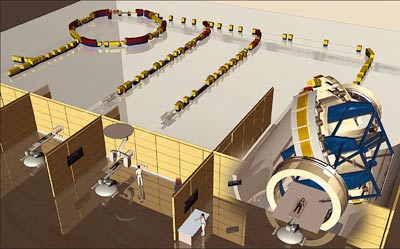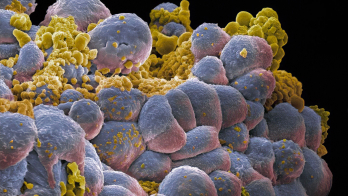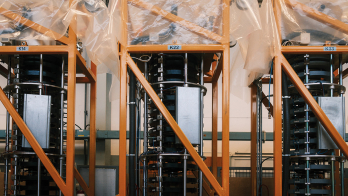
Image credit: HIT.
The Heidelberg Ion Therapy Centre (HIT) celebrated its opening at the Heidelberg University Hospital on 2 November. Developed with scientists and engineers at GSI in Darmstadt, the novel ion-beam cancer therapy facility is now ready to treat large numbers of patients, some 1300 a year.
HIT uses beams of ions, i.e. positively charged carbon or hydrogen atoms, which penetrate the body and exert their full impact deep within the tissue. To reach the tumour tissue, the ion beams are accelerated and then steered with such precision that they can irradiate a tumour the size of a tennis ball with millimetre accuracy, point by point. The surrounding healthy tissue remains mostly unaffected, so the method is particularly suited for treating deep-seated tumours that are close to vital or important organs such as the brain stem or the optic nerve.
The new facility has grown out of pioneering work at GSI, which has conducted fundamental research in radiobiology, nuclear physics and accelerator technology for therapeutic uses since 1980. The construction of a pilot ion-therapy project at GSI began in 1993 in a collaboration between GSI, the Heidelberg University Hospital, the Deutsches Krebsforschungszentrum in Heidelberg and the Forschungszentrum Dresden-Rossendorf.
At the same time, plans were made to introduce ion-beam therapy as a regular component of patient care with a new clinical facility at Heidelberg. HIT thus represents a direct transfer of technology from the GSI pilot project, which introduced several innovative techniques. These included: the raster scan method, which allowed tailored tumour irradiation with a carbon-ion beam; an accelerator that permits rapid variation in the energy of the ion beam in order to adjust the penetration depth inside a tumour; a fast control system to steer the ion beam safely inside the patient at millisecond intervals; and monitoring of the irradiation through a positron emission tomography (PET) camera, to make sure the beam hits the tumour.
Since 1997, 440 patients, most of them with tumours at the base of the skull, have been treated with carbon ion beams at the GSI facility. Clinical studies proved the success of the treatment, documenting a cure rate of up to 90%. Ion-beam treatment is now an accepted therapy, with health-insurance providers refunding the costs.
The new treatment centre is operated by the Heidelberg University Hospital, where a special building with a floor space of 60 m × 80 m was constructed to host it. The facility has a 5 m long linear accelerator and a synchrotron with a diameter of 20 m. Three treatment spaces are located adjacent to the accelerators, two of which are a development of technology used at GSI. The third treatment space features a gantry – a rotating ion-beam guidance system – that is a direct advance on the prototype developed at GSI. The gantry allows the ion beam to be aimed at a patient’s tumour at any angle, thus greatly enhancing the treatment options.
The ion-beam cancer treatment available at HIT is the first of its kind. Japan is currently the only other country offering ion-beam cancer therapy, but with a less effective irradiation technique. In the scope of a licence agreement between the GSI and Siemens AG, two more facilities modelled on HIT are under construction in Marburg and Kiel.








